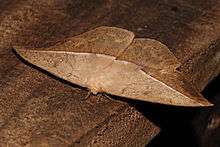Lonomia
The genus Lonomia is a moderate-sized group of fairly cryptic saturniid moths from South America, famous not for the adults, but for their highly venomous caterpillars, which are responsible for a few deaths each year,[1] especially in southern Brazil, and the subject of hundreds of published medical studies. They are commonly known as giant silkworm moth, a name also used for a wide range of other saturniid moths.[2]
| Lonomia | |
|---|---|
.jpg) | |
| L. electra Mount Totumas cloud forest, Panama | |
| Caterpillar of Lonomia obliqua | |
| Scientific classification | |
| Kingdom: | Animalia |
| Phylum: | Arthropoda |
| Class: | Insecta |
| Order: | Lepidoptera |
| Family: | Saturniidae |
| Genus: | Lonomia Walker, 1855 |
| Species | |
|
See text | |
| Diversity | |
| 14 species | |

Description
The caterpillars are themselves extremely cryptic, blending in against the bark of trees, where the larvae commonly aggregate. The larvae, like most hemileucines, are covered with urticating hairs, but these caterpillars possess a uniquely potent anticoagulant venom.[3]
Toxicity
A typical envenomation incident involves a person unknowingly leaning against, placing their hand on, or rubbing their arm against a group of these caterpillars that are gathered on the trunk of a tree. The effects of a dose from multiple caterpillars can be dramatic and severe, including massive internal hemorrhaging, kidney failure, and hemolysis. The resulting medical syndrome is sometimes called lonomiasis. Death may result, either rapidly or after many days following envenomation.[4]
The LD50 of the Lonomia venom is 0.19 mg for an 18–20 g mouse (IV); however, due to the small amount of venom in the bristles of the caterpillar, the rate of human fatality is only 1.7%.[5]
While there are more than a dozen species in the genus, the most troublesome species is Lonomia obliqua, and it is this species on which most of the medical research has centered. As anticoagulants have some very beneficial applications (e.g., prevention of life-threatening blood clots) the research is motivated by the possibility of deriving some pharmaceutically valuable chemicals from the toxin.
Species
- Lonomia achelous (Cramer, 1777) — Bolivia, Venezuela, Colombia, Ecuador, French Guiana, Brazil, Peru, Suriname
- Lonomia beneluzi Lemaire, 2002 — French Guiana
- Lonomia camox Lemaire, 1972 — Venezuela, French Guiana, Suriname
- Lonomia columbiana Lemaire, 1972 — Costa Rica, Panama, Colombia
- Lonomia descimoni Lemaire, 1972 — Bolivia, Colombia, Ecuador, French Guiana, Peru, Suriname, Brazil, Suriname
- Lonomia diabolus Draudt, 1929 — Brazil, French Guiana
- Lonomia electra Druce, 1886 — Central America up to Mexico
- Lonomia francescae L. Racheli, 2005 — Ecuador
- Lonomia frankae Meister, Naumann, Brosch & Wenczel, 2005 — Peru
- Lonomia obliqua Walker, 1855 — Argentina, Brazil, Uruguay
- Lonomia pseudobliqua Lemaire, 1973 — Bolivia, Colombia, Ecuador, Venezuela, Peru
- Lonomia rufescens Lemaire, 1972 — Nicaragua to Panama, Colombia, Peru
- Lonomia serranoi Lemaire, 2002 — El Salvador
- Lonomia venezuelensis Lemaire, 1972 — Venezuela
Notes
- Chan, Kris; et al. (2008-07-15). "Caterpillar-induced bleeding syndrome in a returning traveller". Canadian Medical Association Journal. Retrieved 2015-03-17.
- Meyer, W.L. (May 1, 1996), "Chapter 23: Most Toxic Insect Venom", Book of Insect Records, Gainesville, Florida: Department of Entomology & Nematology, University of Florida, retrieved March 18, 2011
- Pinto, Antônio F.M.; Berger, Markus; Reck Jr., José; Terra, Renata M.S.; Guimarães, Jorge A. "Lonomia obliqua venom: In vivo effects and molecular aspects associated with the hemorrhagic syndrome". Toxicon. Volume 56, Issue 7, 15 December 2010, Pages 1103–1112
- Chan, K., Lee, A., Onell, R., Etches, W., Nahirniak, S., Bagshaw, S. M., & Larratt, L. M. (2008). Caterpillar-induced bleeding syndrome in a returning traveller. Canadian Medical Association journal 179(2), 158–161. doi:10.1503/cmaj.071844
- - Chudzinski-Tavassi & Carrijo-Carvalho (2005) – Biochemical and Biological properties of Lonomia obliqua bristle extract, Table 1 – Laboratory of Biochemistry and Biophysics, Butantan Institute, São Paulo, Brazil.
References
- American Journal of Tropical Medicine & Hygiene article on hemolytic effects
- Arocha-Pinango C.L., Guerrero B. (2001) Lonomia genus caterpillar envenomation: clinical and biological aspects. Haemostasis 31(3–6):288-93.
- Gamborgi G.P., Metcalf E.B., Barros E.J. (2006) Acute renal failure provoked by toxin from caterpillars of the species Lonomia obliqua. Toxicon 47(1):68–74.
- Pinto A.F., Silva K.R., Guimaraes J.A. (2006) Proteases from Lonomia obliqua venomous secretions: comparison of procoagulant, fibrin(ogen)olytic and amidolytic activities. Toxicon 47(1):113-21.
- Veiga A.B., Ribeiro J.M., Guimaraes J.A., Francischetti I.M. (2005) A catalog for the transcripts from the venomous structures of the caterpillar Lonomia obliqua: identification of the proteins potentially involved in the coagulation disorder and hemorrhagic syndrome. Gene 355:11–27.
External links
- Saturniidae World: Pictures of all species